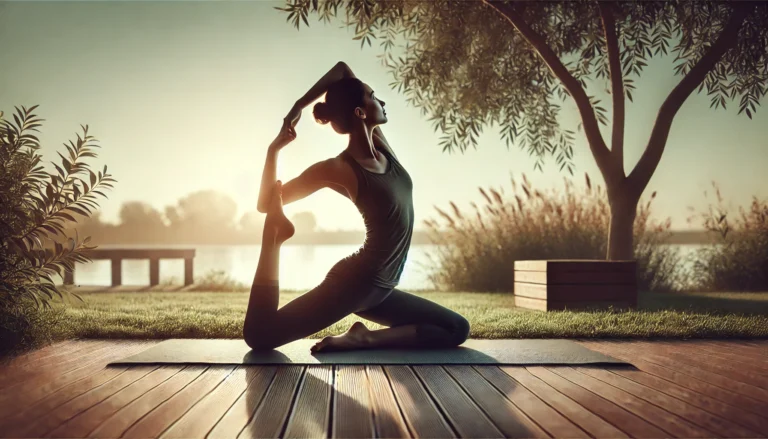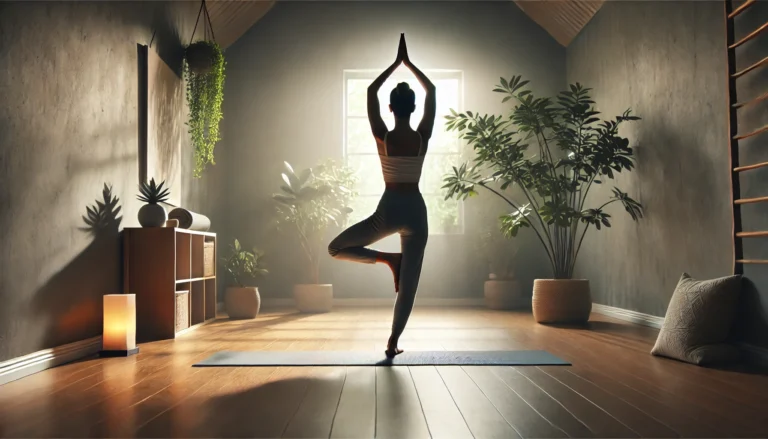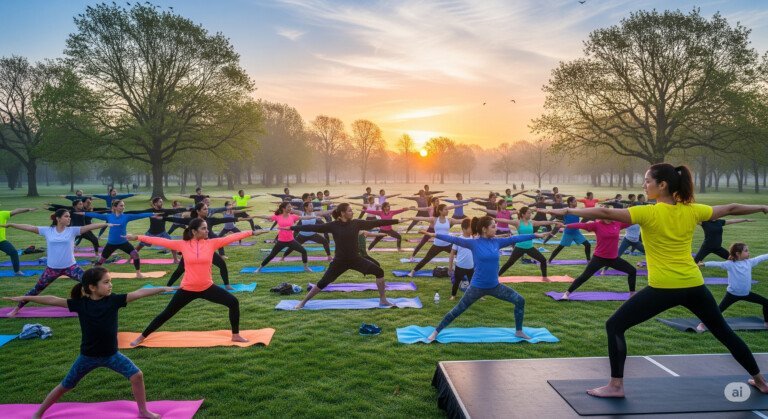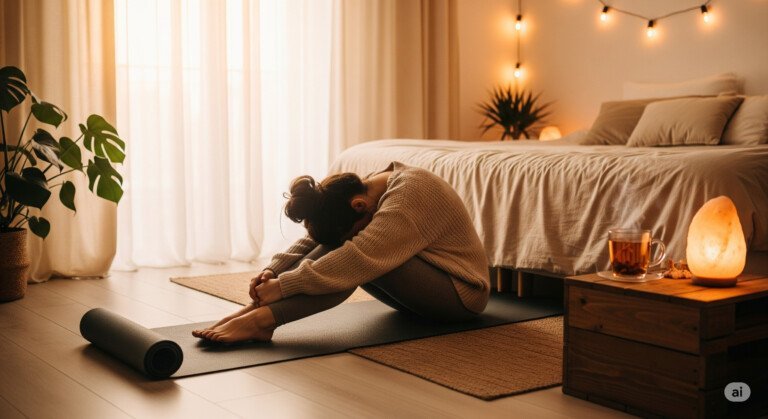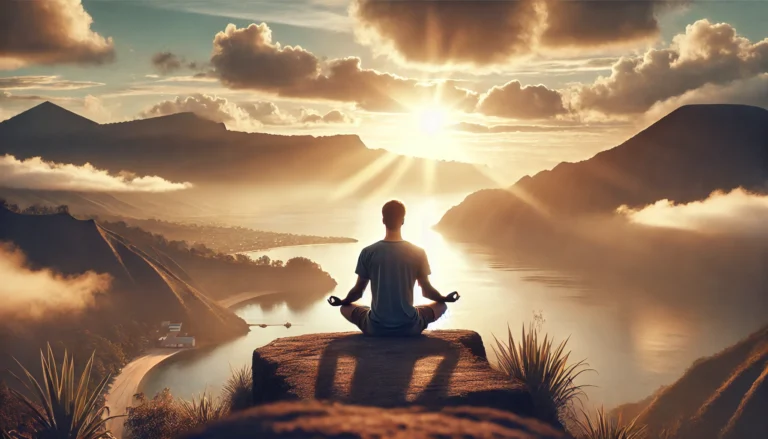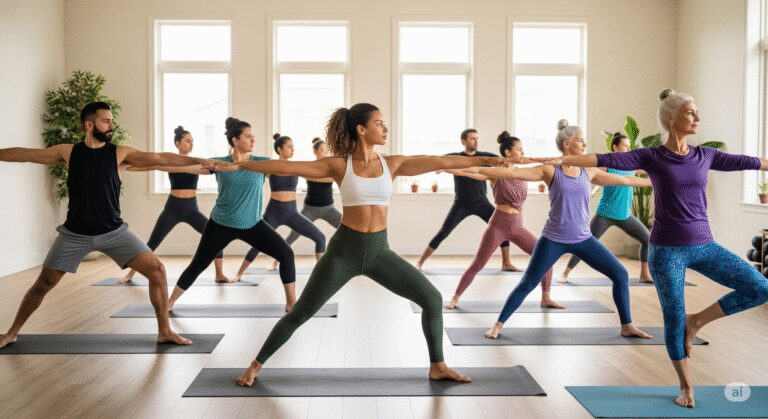Bikram Yoga Poses: 7 Powerful Things You Need to Know
Bikram yoga poses are more than a workout—they’re a structured path to mental and physical transformation. Practiced in a heated room, this 26-pose sequence challenges every part of your body. If you’re new or curious, here are 7 powerful things you need to know before you roll out your mat.
Thank you for reading this post, don't forget to subscribe!1. Bikram Yoga – Intoduction
The first time I entered a Bikram yoga class, the heat was the first thing I noticed. It was suffocating yet strangely invigorating. My stomach fluttered with both excitement and anxiety as I set up my mat, unsure of what awaited me in that room, filled with both seasoned practitioners and other beginners. I had heard so much about Bikram yoga—how it was intense, how it would push my body to new limits, and how I’d likely sweat more than I ever had in my life. Little did I know, I was about to undergo a life-changing experience.
As the class began and the instructor guided us through the sequence of 26 poses, I found myself captivated by the focus required. The heat worked its magic on my muscles, allowing me to stretch deeper than I thought was possible. The 90-minute session was grueling, but by the end of it, I felt like a new person—calmer, stronger, and more centered. It was the beginning of a journey that would teach me not only about physical flexibility but mental resilience as well.
If you’re thinking about stepping into a Bikram yoga class, it’s crucial to know what you’re getting into. While it may seem intimidating at first, the benefits of Bikram yoga are worth the effort. In this blog, we’ll explore everything you need to know before taking that first step into the heated room.

2. A Breakdown of the 26 Classic Bikram Yoga Poses
One of the most defining features of Bikram yoga is its consistent structure. The 26 classic Bikram yoga poses are always performed in the same sequence, regardless of the instructor. This predictability allows your body to adapt more quickly to the routine, while also helping your mind focus on mastering each pose. So, what are these 26 poses? Here’s a deeper dive into each of them:
1. Standing Deep Breathing (Pranayama Series)
Target Areas: Lungs, diaphragm, chest
Benefits:
- Prepares the body and mind for the session
- Increases lung capacity and oxygen flow
- Improves breathing technique
Description:
This pose involves standing with your feet together while inhaling and exhaling deeply. It helps expand the chest, improve lung capacity, and prepare the body for the challenging poses that follow.

2. Half Moon Pose with Hands to Feet (Ardha Chandrasana with Padahastasana)
Target Areas: Spine, hips, thighs, and arms
Benefits:
- Improves balance
- Lengthens the spine and stretches the sides of the body
- Increases flexibility in the hips and thighs
Description:
In this pose, you stretch your body to the side while balancing on one leg, with your hands placed flat on the floor beside your feet. It challenges your flexibility and balance while toning the body.
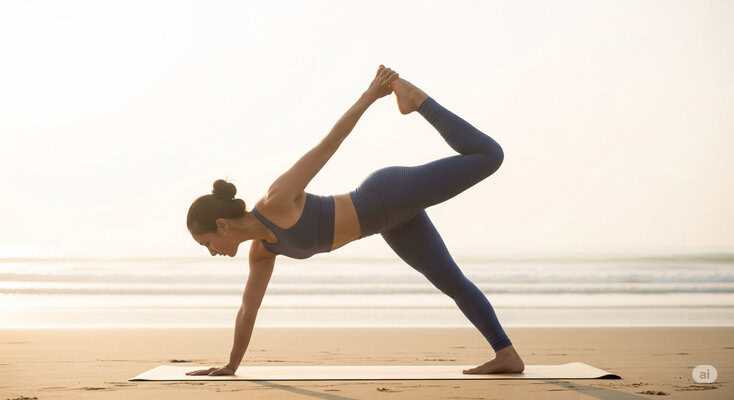
3. Awkward Pose (Utkatasana)
Target Areas: Thighs, calves, hips, and core
Benefits:
- Builds strength in the legs
- Tones the abdominal muscles
- Stretches the hips and lower back
Description:
In this pose, you squat with your knees bent deeply, thighs parallel to the floor. Your arms are extended straight in front of you. The pose strengthens the legs and engages the core, building endurance.
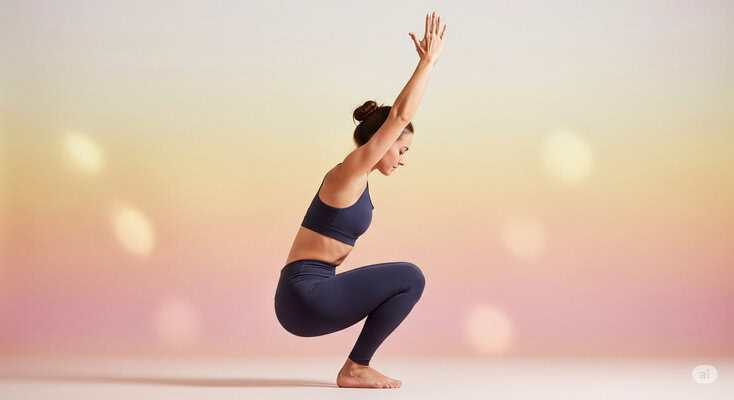
4. Eagle Pose (Garudasana)
Target Areas: Thighs, hips, shoulders, arms
Benefits:
- Improves balance and coordination
- Stretches the outer hips, shoulders, and thighs
- Enhances flexibility and mental focus
Description:
This pose involves wrapping your legs and arms together while standing. You balance on one leg, creating a figure-eight shape with your limbs. It challenges balance and coordination, stretching the body’s lower and upper extremities.
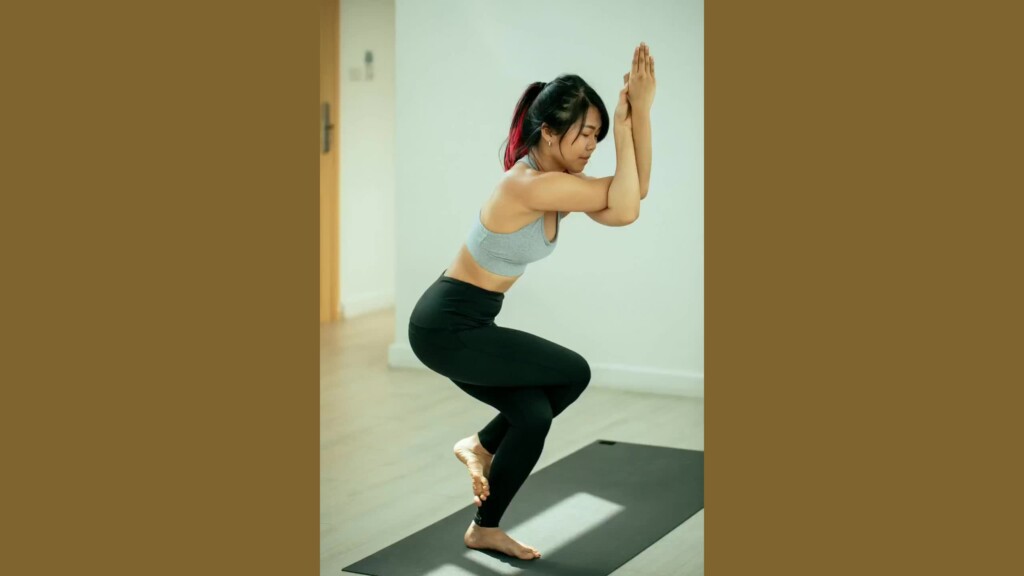
5. Standing Head to Knee Pose (Dandayamana-Janushirasana)
Target Areas: Hamstrings, core, spine
Benefits:
- Improves flexibility in the legs and spine
- Strengthens the abdominal muscles
- Builds mental focus and concentration
Description:
In this pose, you balance on one leg while reaching your forehead toward your knee, pulling the leg you’re standing on straight. It requires balance and flexibility, stretching the hamstrings and building core strength.
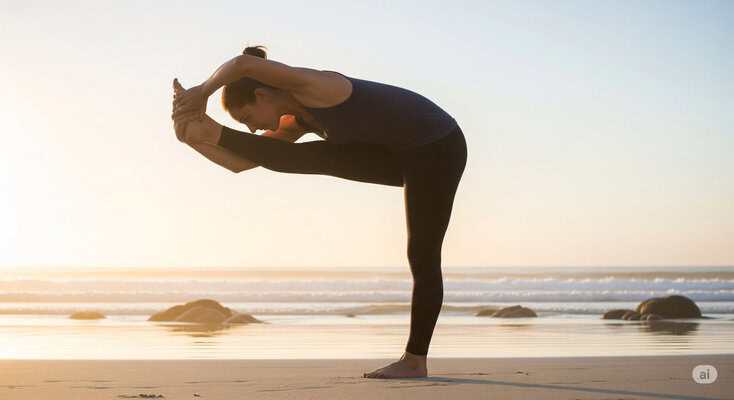
6. Standing Bow Pulling Pose (Dandayamana-Dhanurasana)
Target Areas: Chest, back, thighs, hips, and shoulders
Benefits:
- Opens the chest and shoulders
- Increases balance and flexibility
- Strengthens the legs and spine
Description:
In this pose, you balance on one leg while pulling your other leg behind you with one hand and reaching the opposite arm forward. It stretches the front of your body and strengthens the back and legs.
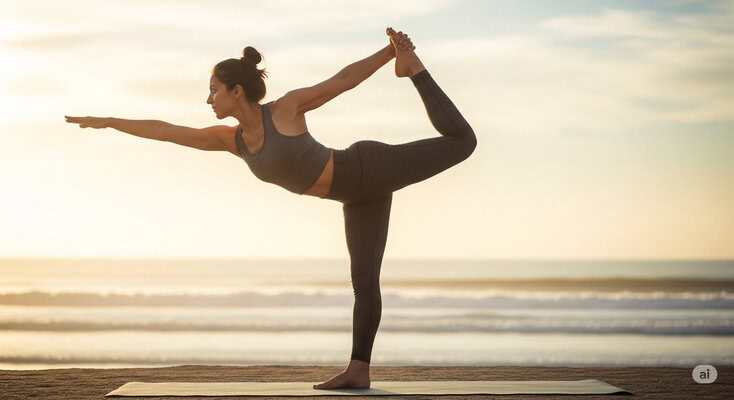
7. Balancing Stick Pose (Tuladandasana)
Target Areas: Core, legs, shoulders, spine
Benefits:
- Improves balance and flexibility
- Tones and strengthens the core and legs
- Stretches the spine
Description:
In Balancing Stick Pose, you stretch your body forward, balancing on one leg while keeping your body parallel to the floor. The challenge here is to maintain a straight line from the fingertips to the toes.

8. Standing Separate Leg Head to Knee Pose (Dandayamana-Bibhaktapada-Janushirasana)
Target Areas: Hamstrings, lower back
Benefits:
- Stretches the hamstrings and lower back
- Improves flexibility in the legs
- Strengthens the legs and core
Description:
This pose involves standing with your legs wide apart and bending down to touch your head to one knee. It is excellent for improving hamstring flexibility and creating a deep stretch in the back and legs.
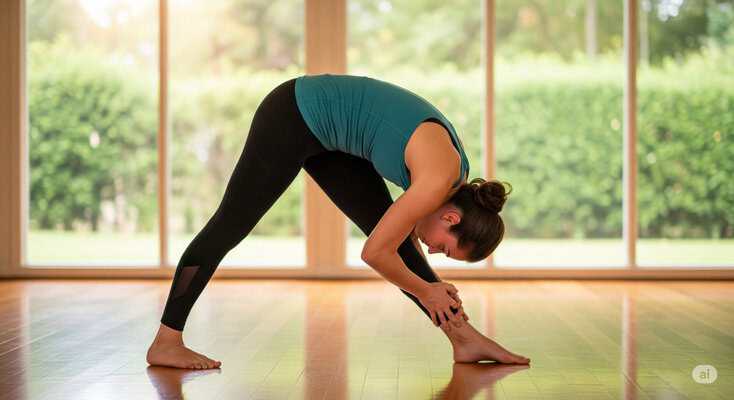
9. Triangle Pose (Trikonasana)
Target Areas: Hips, spine, legs, shoulders
Benefits:
- Stretches the spine, hips, and legs
- Improves posture and balance
- Strengthens the legs and opens the chest
Description:
In this pose, you stretch your legs wide and extend your arms, reaching toward your foot. You then bend to the side, aiming to touch the floor while keeping your body open and the chest lifted. This pose improves flexibility and strength in the legs and spine.
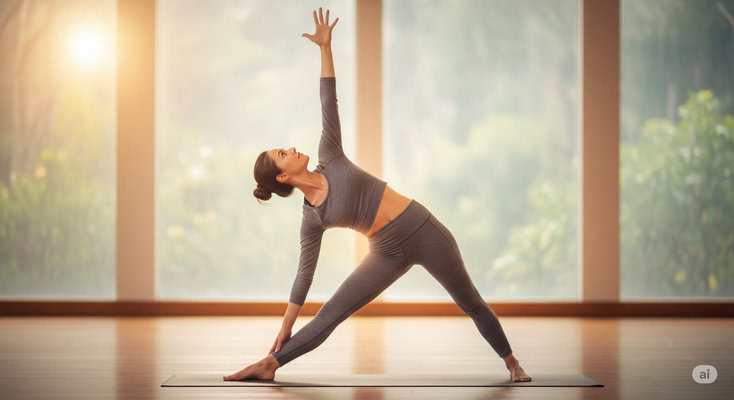
10. Standing Separate Leg Forward Bend Pose (Dandayamana-Bibhaktapada-Paschimottanasana)
Target Areas: Hamstrings, calves, lower back
Benefits:
- Deep stretch for the hamstrings and lower back
- Improves flexibility
- Helps lengthen the spine
Description:
This standing forward bend focuses on stretching the hamstrings and lower back. Keeping your legs straight, bend forward, aiming to touch your forehead to the floor.
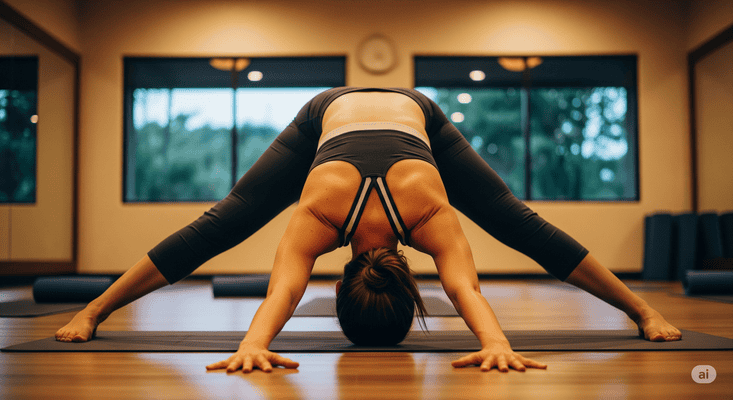
11. Tree Pose (Tadasana)
Target Areas: Balance, legs, hips
Benefits:
- Improves balance and focus
- Strengthens the legs
- Opens the hips and promotes stability
Description:
A standing balance pose in which one foot is placed on the inner thigh or calf of the opposite leg, while the arms are raised above the head in a prayer position. This pose teaches balance, focus, and stability.
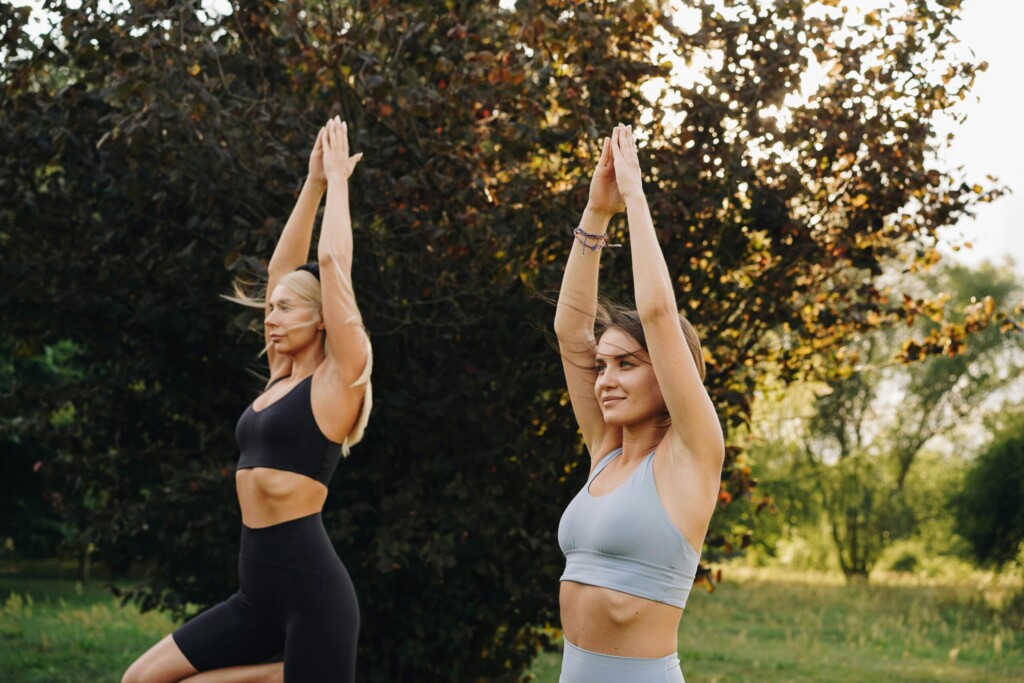
12. Toe Stand (Padangustasana)
Target Areas: Ankles, calves, thighs, core
Benefits:
- Improves balance and concentration
- Strengthens the ankles and calves
- Enhances mental focus and stability
Description:
Toe Stand is a balance pose performed by standing on one leg while slowly lowering your body into a squat position with your opposite foot on the thigh of the standing leg. The pose requires focus and concentration to maintain balance, making it an excellent exercise for building mental clarity and ankle stability.
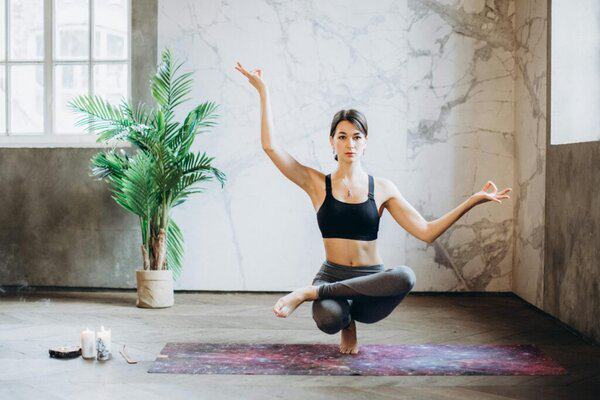
13. Savasana (Corpse Pose)
Target Areas: Full body relaxation
Benefits:
- Promotes deep relaxation and stress relief
- Helps lower blood pressure and calm the nervous system
- Aids in mental clarity and mindfulness
Description:
Savasana is the final pose of a Bikram yoga class and is performed lying flat on your back with arms extended alongside your body. This restorative pose is designed to help the body absorb the benefits of the practice while promoting deep relaxation. It is often referred to as the most important pose because it allows the body and mind to integrate the energy and clarity gained during the session.
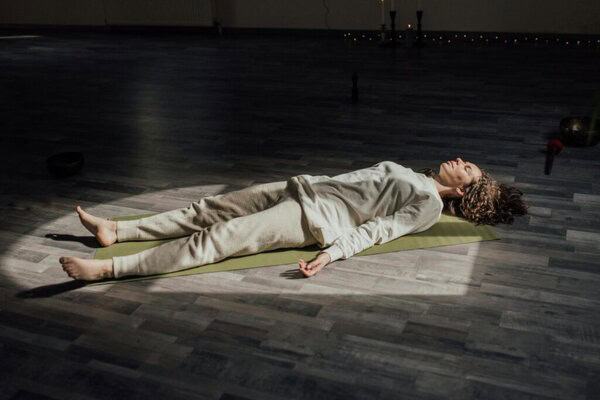
14. Wind-Removing Pose (Pavanamuktasana)
Target Areas: Lower abdomen, hips
Benefits:
- Relieves tension in the lower back
- Promotes digestion
- Releases gas and bloating
Description:
Lying on your back, pull one or both knees into your chest while keeping your head and shoulders relaxed on the floor. This pose helps release trapped gas and tension in the abdominal area.
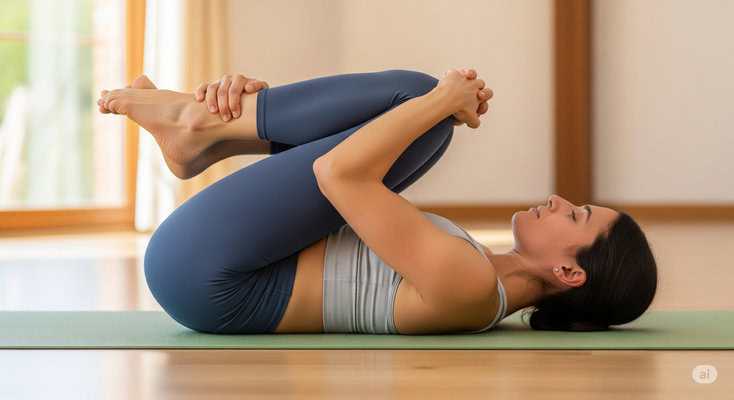
15. Sit-up (Paschimottanasana Variation)
Target Areas: Core, spine, hamstrings
Benefits:
- Strengthens the abdominal muscles
- Stretches the hamstrings and lower back
- Improves spinal flexibility
Description:
The Sit-up is performed between the spine-strengthening postures and involves a dynamic movement that strengthens the core and stretches the back and hamstrings. It is typically done by lying on the floor, performing a controlled sit-up motion, and engaging the abdominal muscles to sit upright. This movement helps with spinal mobility and core activation.
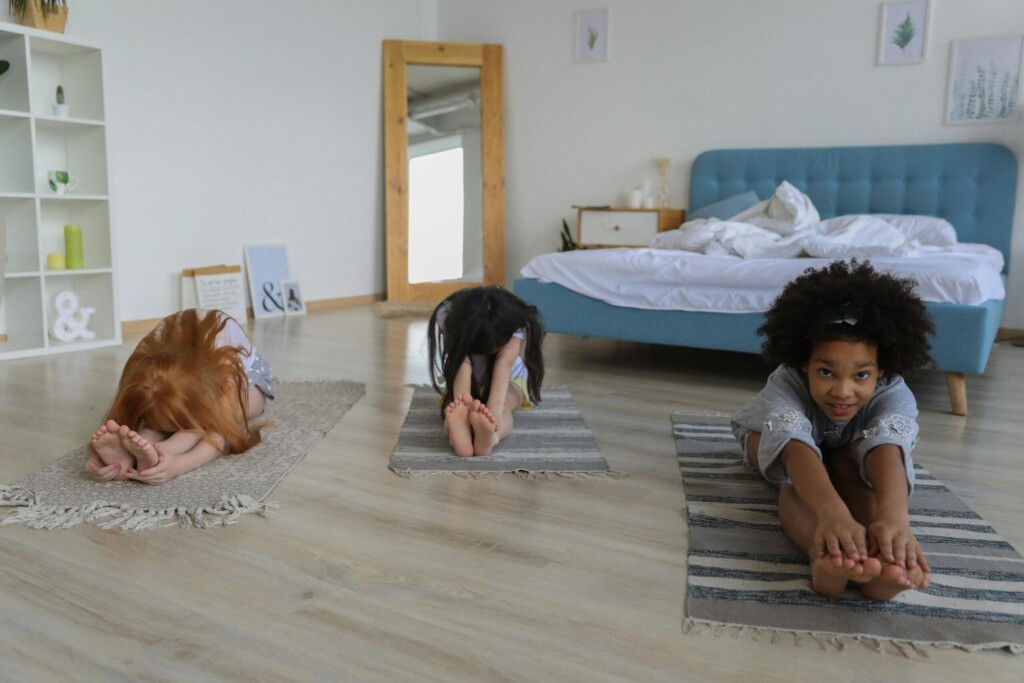
16. Cobra Pose (Bhujangasana)
Target Areas: Spine, chest, shoulders
Benefits:
- Opens the chest and stretches the spine
- Strengthens the lower back
- Increases flexibility in the upper back
Description:
This backbend stretches the chest and spine. Lying on your stomach, you lift your chest off the ground with the support of your arms, arching your back.

17. Locust Pose (Salabhasana)
Target Areas: Back, glutes, legs
Benefits:
- Strengthens the back and glutes
- Improves posture
- Opens the chest and shoulders
Description:
Lying face down, you lift both your legs and upper body off the ground while keeping your arms stretched along the sides. This strengthens the lower back and glutes while improving flexibility in the chest and shoulders.
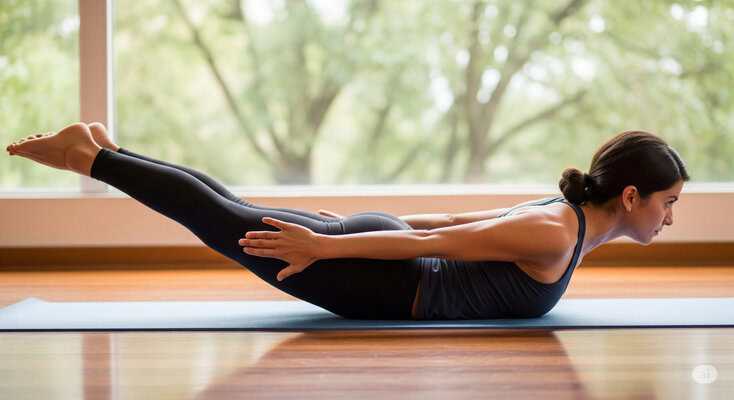
18. Full Locust Pose (Poorna Salabhasana)
Target Areas: Spine, glutes, arms
Benefits:
- Strengthens the back and glutes
- Improves posture
- Stretches the chest and shoulders
Description:
A more advanced version of Locust Pose, you lift both your upper and lower body off the ground, engaging the entire back and legs. This challenges your balance and strengthens your core.
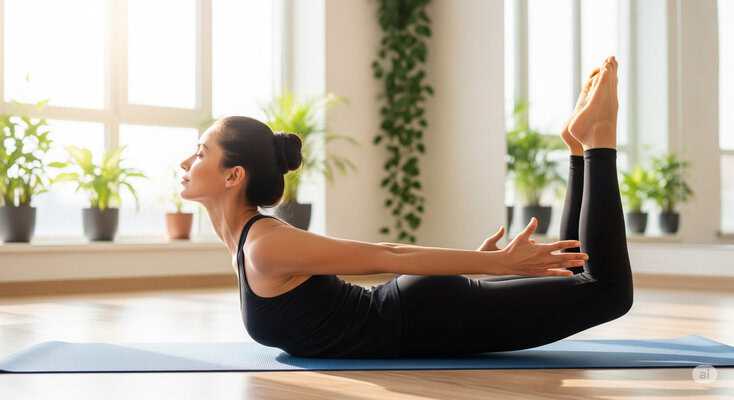
19. Bow Pose (Dhanurasana)
Target Areas: Chest, abdomen, hips, back
Benefits:
- Stretches the chest, abdomen, and hip flexors
- Strengthens the back and arms
- Improves posture
Description:
In Bow Pose, you lie on your stomach and hold your ankles while lifting both your chest and legs off the ground. This deep backbend opens the chest, stretches the hip flexors, and strengthens the spine.

20. Fixed Firm Pose (Supta-Vajrasana)
Target Areas: Quads, knees, lower back
Benefits:
- Deep stretch for the quadriceps and knees
- Improves flexibility in the lower back
- Relieves tension in the lower body
Description:
This seated pose involves sitting with your legs bent underneath you, with your arms reaching backward to support your back. It helps stretch the quadriceps and release tension in the lower back.
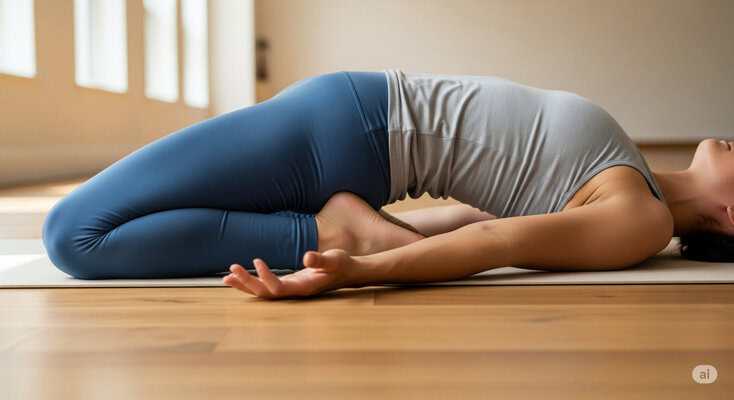
21. Half Tortoise Pose (Ardha-Kurmasana)
Target Areas: Spine, shoulders, arms
Benefits:
- Stretches the spine and shoulders
- Promotes deep relaxation
- Improves circulation
Description:
In this pose, you sit on your knees and stretch your arms forward, lowering your chest toward the floor. It helps to lengthen the spine and promote deep breathing and relaxation.
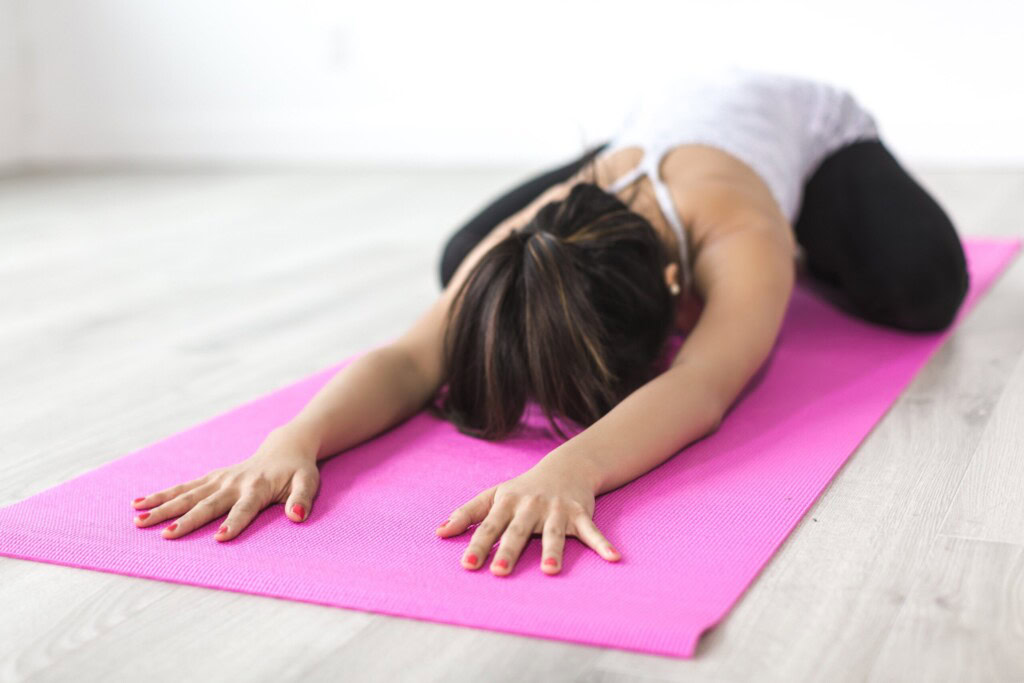
22. Camel Pose (Ustrasana)
Target Areas: Chest, abdomen, hip flexors, spine
Benefits:
- Opens the chest and stretches the hip flexors
- Strengthens the lower back
- Improves posture and spinal flexibility
Description:
In Camel Pose, you kneel and bend backward, reaching for your heels with your hands. This backbend opens the chest and abdomen while stretching the hip flexors and strengthening the spine.
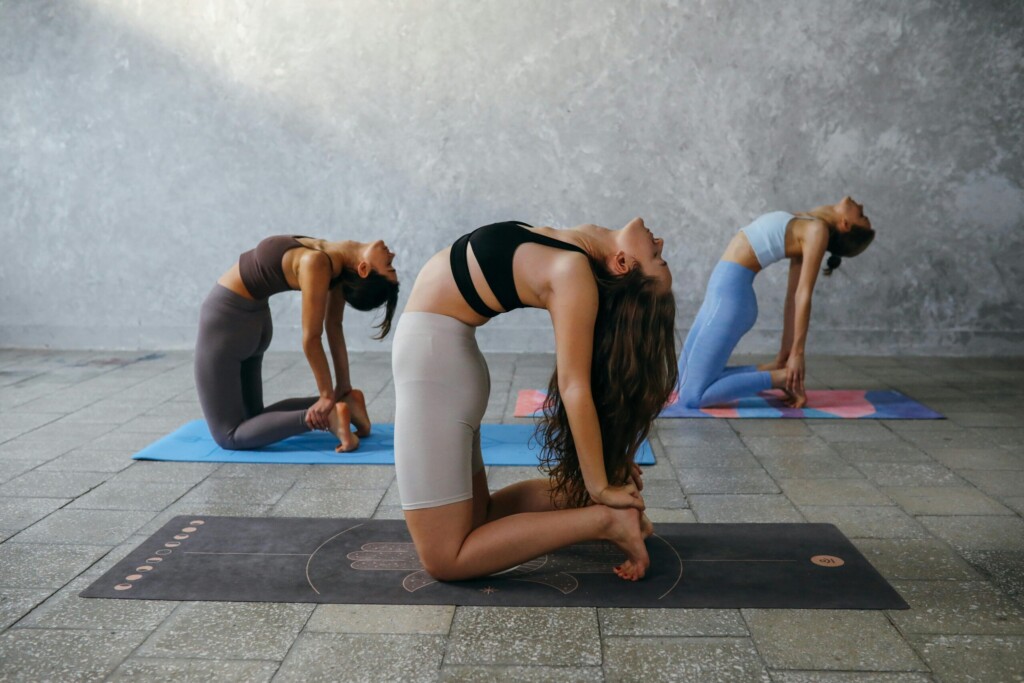
23. Rabbit Pose (Sasangasana)
Target Areas: Neck, spine, back
Benefits:
- Relieves tension in the spine and neck
- Stretches the back and shoulders
- Calms the nervous system
Description:
In Rabbit Pose, you kneel on the floor, then fold forward, placing your forehead on the ground and pulling your feet toward your head. This pose stretches the back and neck while calming the mind.
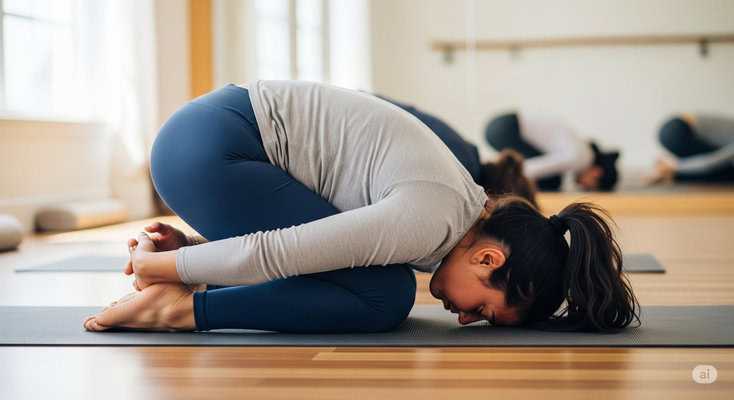
24. Head to Knee Pose (Janushirasana)
Target Areas: Hamstrings, calves, lower back
Benefits:
- Stretches the hamstrings and lower back
- Increases flexibility
- Improves posture
Description:
This seated forward bend targets the hamstrings and lower back. With one leg extended and the other bent, you reach your forehead toward the knee of the extended leg.
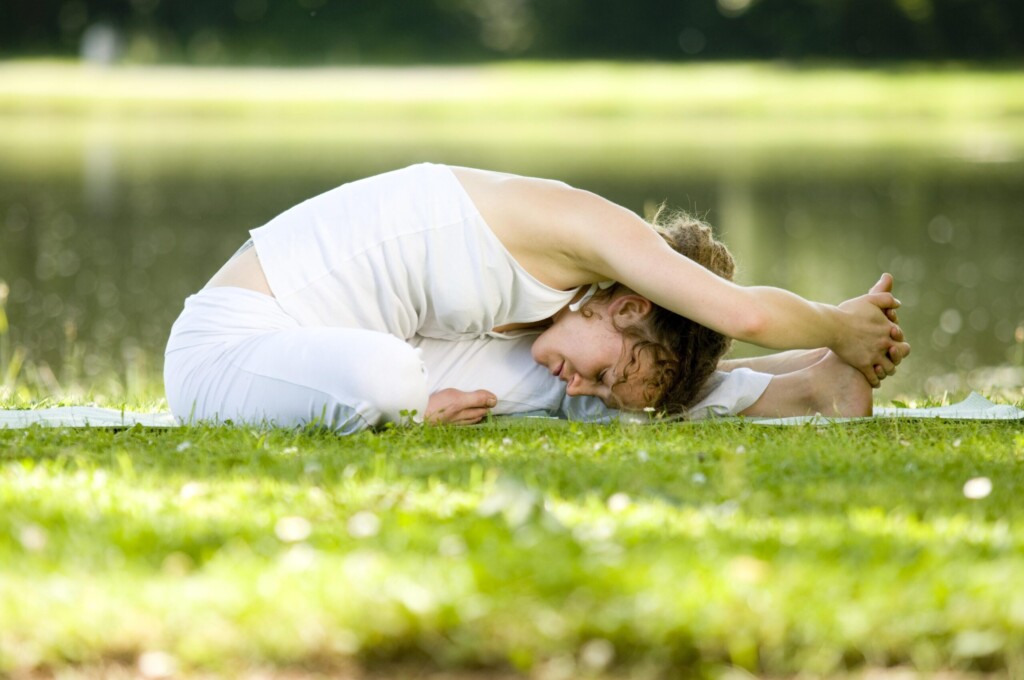
25. Spine Twist Pose (Ardha-Matsyendrasana)
Target Areas: Spine, hips
Benefits:
- Improves spinal mobility
- Relieves tension in the back
- Promotes detoxification and better digestion
Description:
In this seated twist, you rotate your spine to one side while keeping your legs straight and arms extended. It helps improve flexibility in the spine and aids in digestion.
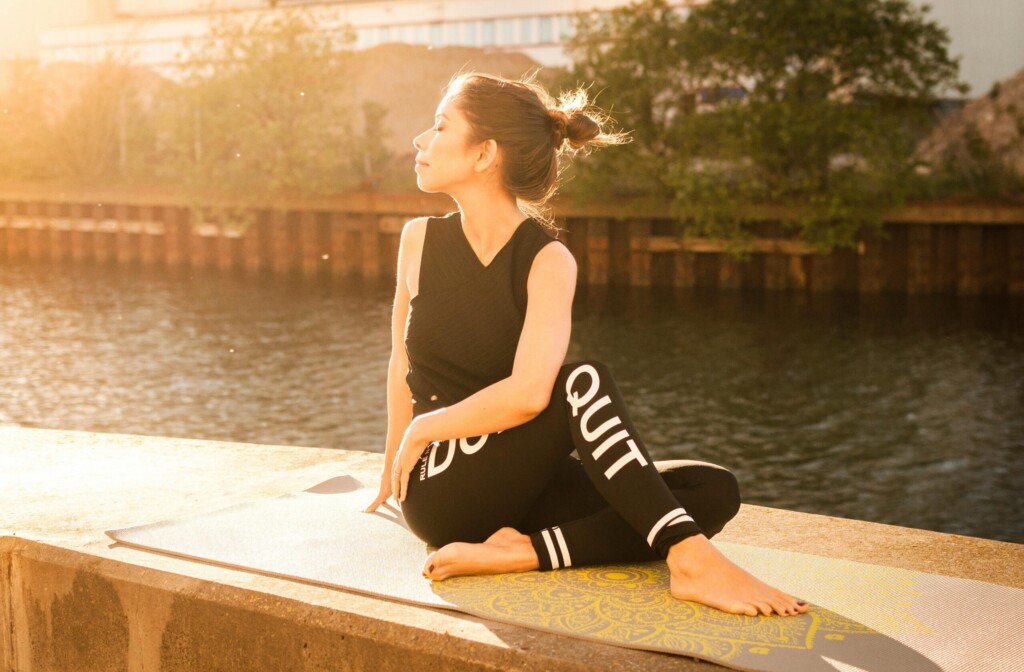
26. Blowing in Firm Pose (Kapalbhati in Vajrasana)
Target Areas: Abdomen, lungs
Benefits:
- Improves lung capacity
- Stimulates abdominal muscles
- Clears the respiratory system
Description:
This breathing exercise involves sitting in a kneeling position and forcefully exhaling while focusing on deep abdominal breathing. It helps to detoxify the body and calm the nervous system.
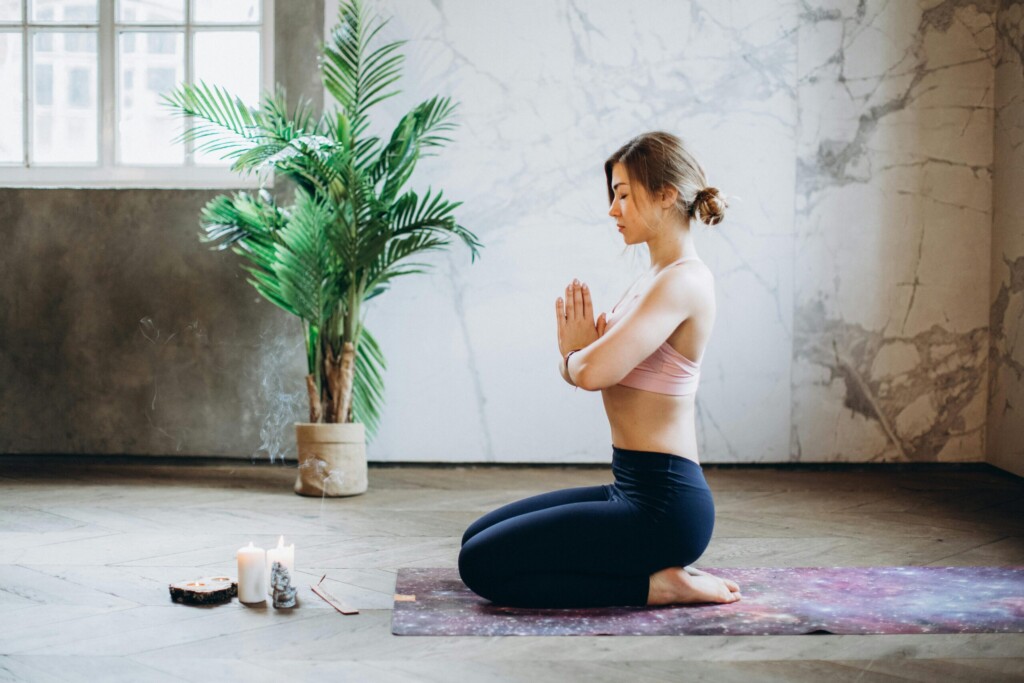
3. Physical & Mental Benefits
Bikram yoga isn’t just a physical workout; it’s a holistic approach to well-being. The intense heat helps to open your muscles, making them more flexible and allowing you to reach deeper stretches. But it’s the combination of physical effort, breath control, and mental discipline that makes Bikram yoga truly transformative.
Physical Benefits:
- Increased Flexibility – The heat helps muscles become more pliable, making it easier to perform deep stretches and reach new levels of flexibility.
- Strengthened Core – Many poses target the core muscles, promoting better posture and reducing the risk of injury in daily activities.
- Improved Balance – Bikram yoga helps enhance coordination and balance through various standing and balancing postures.
- Detoxification – Sweating is a major part of Bikram yoga, and it helps flush out toxins from the body, promoting overall health.
- Weight Loss – The high-intensity nature of the practice burns calories and helps with fat loss while improving muscle tone.
Mental Benefits:
- Stress Relief – Bikram yoga’s focus on breathing and mindfulness helps reduce stress and anxiety, leaving you feeling centered and relaxed after class.
- Increased Focus – As you hold challenging poses, the practice encourages mental focus, which translates into improved concentration in all aspects of life.
- Resilience and Patience – The heat and intensity of the practice teach you how to embrace discomfort, building mental toughness that extends beyond the mat.
Bikram yoga helps you develop both physical and mental resilience. While the physical benefits are obvious, the mental clarity you gain is equally valuable. As your body becomes stronger and more flexible, your mind becomes clearer, and your stress levels decrease.
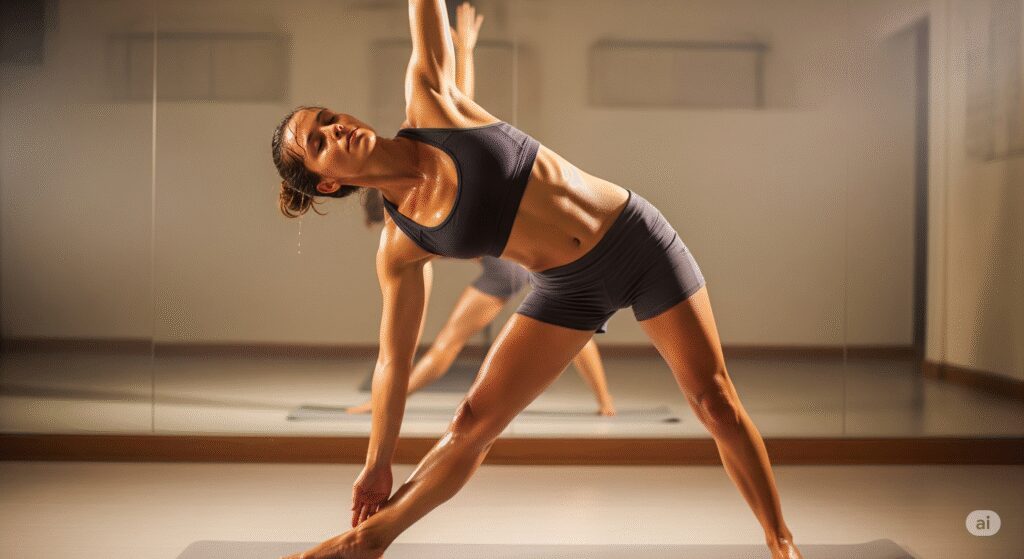
4. The Required Discipline and Routine
To succeed in Bikram yoga, consistency is key. It’s not just about showing up—it’s about showing up with the right mindset and dedication. The structure of each class is designed to challenge your body and mind, and following this routine regularly will yield the best results.
The 26-posture sequence can be intense, and it requires a level of discipline to continue pushing through each pose. It can be easy to get frustrated when you don’t feel like you’re progressing, but the beauty of Bikram yoga lies in its repetitive nature. With every class, you get better, stronger, and more aware of your body’s capabilities.
Yoga and discipline go hand-in-hand in Bikram yoga. Each time you step into that heated room, you’re not just committing to improve your physical health, but also your mental discipline. Bikram yoga teaches you patience, humility, and resilience.

5. Exactly What to Wear to Hot Yoga
What to wear to hot yoga is a common question for newcomers. In Bikram yoga, comfort and breathability are crucial. The hot, humid environment can make you sweat profusely, so wearing the right clothes is key to staying comfortable and focused.
For women, moisture-wicking tops and form-fitting shorts or leggings are the best choice. The clothing should stay in place as you move through the various poses. Many prefer wearing sports bras for comfort and support.
For men, lightweight, moisture-wicking shorts or tank tops work best. These allow for ease of movement and ensure you don’t get distracted by uncomfortable or restricting clothing during class.
It’s also important to bring a large towel for wiping off sweat and a water bottle to stay hydrated. The heat can quickly lead to dehydration, so drinking water before, during, and after class is vital.

6. Certifications & the Myth of certified-yoga.com Members
If you’ve been researching yoga certifications, you may have encountered programs offering “certified-yoga.com” membership. But what does that really mean? Are these certifications legitimate?
In the world of yoga, certification matters. Reputable certifications are offered by established organizations like Yoga Alliance, which ensures that the instructors have met rigorous standards for teaching and practice. While certified-yoga.com member status might sound appealing, it’s crucial to investigate the legitimacy of any yoga certification program before committing to it.
To become a certified Bikram yoga teacher, you should look for programs that offer Bikram Yoga certification through authorized schools. These programs ensure that instructors are trained to teach safely and effectively.

7. Final Advice for Beginners
If you’re new to Bikram yoga, my best advice is to approach it with patience. Your first few classes might be tough—especially due to the heat and intensity. But remember that it’s a journey. Progress won’t happen overnight, but with regular practice, you’ll start seeing improvements in both your body and mind.
Begin with a commitment of two to three classes per week. Hydrate well, listen to your body, and don’t be afraid to take breaks when necessary. Most importantly, enjoy the process.
FAQ
1. What are Bikram yoga poses, and how do they differ from other yoga styles?
Bikram yoga poses are a series of 26 postures, each designed to work the entire body, and are practiced in a heated room (typically 105°F or 40°C). These poses include deep stretches, balance challenges, and strengthening exercises that promote flexibility, detoxification, and overall health. Unlike other yoga styles, Bikram follows a fixed sequence that is practiced consistently to build both physical strength and mental discipline. The heat in the room enhances muscle flexibility, allowing you to stretch deeper into each pose. This focus on consistency, structure, and intensity makes Bikram unique compared to more free-flowing yoga styles such as Vinyasa or Hatha.
2. What should I wear to hot yoga, and how does it affect my practice?
When practicing Bikram yoga, it’s essential to wear lightweight, breathable, moisture-wicking clothing that allows full range of motion. For women, form-fitting sports bras and tank tops with shorts or leggings work well, while men typically opt for moisture-wicking tanks and shorts. The intense heat in the room makes wearing appropriate clothing crucial, as it ensures comfort and helps manage the excessive sweat produced during class. The right attire also minimizes distractions, allowing you to focus on your Bikram yoga poses without feeling restricted. Avoid overly loose clothing that could hinder movement or interfere with posture alignment.
3. How does Bikram yoga promote discipline in my practice and daily life?
Bikram yoga is known for its emphasis on yoga and discipline. The structured format of 26 fixed postures performed in a 90-minute session teaches consistency, patience, and focus. The heat challenges your body both physically and mentally, requiring a disciplined approach to stay present and push through discomfort. Over time, this discipline cultivated on the mat extends into other areas of life—helping you approach challenges with a calm, composed, and focused mindset. This mental resilience is not just a byproduct of the physical practice but an essential part of mastering Bikram yoga poses.
4. Can a certified-yoga.com member teach Bikram yoga, or are special certifications required?
While being a certified-yoga.com member can be an excellent way to deepen your yoga knowledge, teaching Bikram yoga requires specific training and certification. Bikram yoga instructors must complete an accredited Bikram Yoga Teacher Training program, which includes a comprehensive study of the 26 poses, the sequence, and the philosophy behind Bikram’s method. Simply being a certified-yoga.com member does not provide sufficient qualifications to teach Bikram yoga. If you’re interested in teaching, it’s best to pursue an official Bikram yoga certification program recognized by the community to ensure proper training and credibility.
5. How can Bikram yoga help me improve flexibility with regular practice of its poses?
One of the primary benefits of Bikram yoga is its ability to significantly improve flexibility. The combination of heat and carefully sequenced Bikram yoga poses allows muscles to stretch deeply and safely. The heat warms up your body, making it more pliable, which facilitates a greater range of motion and deeper stretches. Poses like Standing Head to Knee Pose and Triangle Pose target key muscle groups, helping you gradually increase flexibility in your hamstrings, back, and hips. With consistent practice, you’ll notice an improvement in your flexibility, as well as a reduction in muscle stiffness and tension.
6. Is it necessary to hydrate more before a Bikram yoga class due to the heat and intensity?
Yes, hydration is crucial before and after a Bikram yoga class due to the high heat and intense sweating. The Bikram yoga poses and the 105°F (40°C) heat can quickly lead to dehydration. It’s recommended to drink plenty of water before entering the studio and to continue hydrating throughout the day. You should also bring a water bottle to class, as staying hydrated helps maintain energy levels and prevents dizziness or fatigue during your practice. Additionally, post-class hydration helps replenish the fluids and electrolytes lost during the session.
7. Can Bikram yoga help me build discipline and improve focus for my daily life and other activities?
Absolutely! The mental discipline gained through Bikram yoga extends far beyond the mat. By consistently practicing Bikram yoga poses in a heated room, you cultivate resilience, patience, and concentration. These qualities are essential for navigating challenges in daily life. The structure and routine of Bikram yoga teach you to push through discomfort, stay focused on the task at hand, and remain disciplined in your practice. Whether you’re at work, in personal relationships, or pursuing other fitness goals, the mental strength gained from Bikram yoga will enhance your ability to stay present, focused, and calm under pressure.
Disclaimer:
This post may contain affiliate links. If you purchase through them, we may earn a small commission at no extra cost to you. Also, this content is for informational purposes only and does not substitute professional medical advice.


